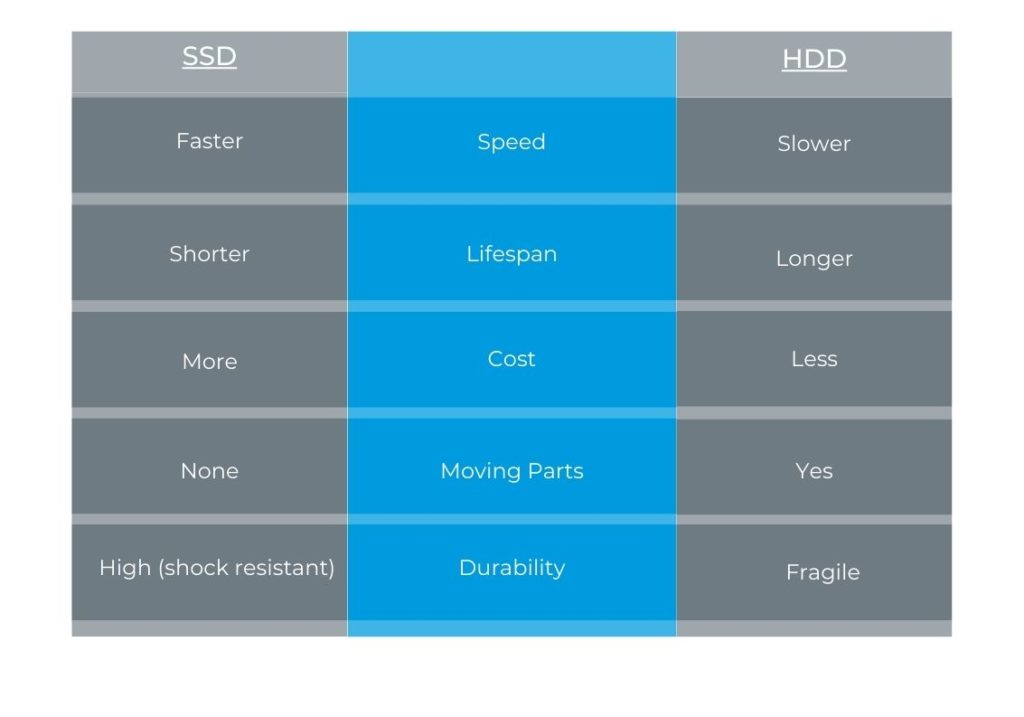What is NAND flash memory used for?
NAND flash is a popular NVM type that provides high capacity. But what is NAND memory used for? And why?
This popular memory type is architecturally optimized for high-density data storage. There are two grades of NAND, consumer and industrial – with the latter having an operating temperature of -40 to 85oC and suitable for harsh environment applications, some of which we’ll be discussing below. Consumer grade, which has an operating temperature of 0 to 70oC, is typically found in consumer electronics, and we’ll discuss some of those too.
NAND as an SSD
Thanks to the availability of large capacity memories for reasonable prices, NAND flash memory is used in solid state drives (SSDs) within many computing platforms, such as laptop and desktop PCs, and mass storage devices such as RAID drives as an alternative to hard disk drives (HDDs).
Flash memory has no moving parts, so either durable than an HDD. It also consumes less power and generates less heat.
Flash can also be accessed more quickly, as reflected in a drive’s I/O per second (IOPS) figure. HDD performance is typically a few 100 IOPS. Flash access is in the tens of thousands of IOPS.
Here’s an overview of SSD versus HDD.

Above, is a comparison of solid state and hard-disk technologies. SSD is best for storing data that is accessed frequently, such as the operating system and applications of a PC or laptop, for example. HDDs are most frequently used as long-term mass storage devices.
Note, SSDs will either use NAND or NOR flash – and if you’d like to learn about the differences, please refer to our What is NAND flash memory? guide.
SSDs have a very similar (and often identical) format to their hard-disk counterparts. Typical interface options are SATA III, PCIe, M2 and NVMe.
NAND for portable storage
NAND flash is used in the majority of removable and portable memory devices such as SD cards and USB thumb drives. Note, NOR is used too but to a far lesser degree.
As mentioned in the introduction, NAND can be commercial or industrial grade. Commercial USB memory devices are ideal for use in the home or office – and that tends to be the realistic extent of their ‘portability’. Industrial grade memory is better suited to harsh environments. However, it’s not just its extended temperature range that makes it so, as the IC and substrate on which it is mounted must be protected from moisture, humidity, dust, oils and chemicals.
Industrial removable memory devices tend to be of a solid over-moulded construction – which makes them virtually crush-proof.
Within a portable storage device, the memory is typically used for one, more or all of the following:
- Data storage – such as the transfer of files.
- System configuration/update – i.e. to provide a product with a new program and/or settings.
- User authentication – to (along with a PIN or password) identify a user and determine their access privileges to a system or building.
NAND memory in automotive
NAND flash is a popular technology within the automotive sector, as a modern car is a wealth of interconnected embedded systems and part of an ever-expanding digitally connected network.
NAND flash’s high capacity and low cost are of great appeal in the sector, as is its durability; specifically, its ability to cope with vibration and work over a relatively wide temperature range (-40 to more than 100oC in some cases), compared to a hard disk drive.
NAND flash is great for data storage as it accommodates fast programming and erase speeds. However, NOR is a better solution for systems that need to read data quickly, to boot, for example. Also, NOR has a longer life than NAND – though the latter (depending on the applications accessing it) should still last as long as the vehicle.
For this reason, automotive systems use a mix of NAND and NOR. For a full comparison of the technologies, please refer to the ‘NAND versus NOR’ table in our ‘What is NAND flash memory?’ guide.
NAND memory in consumer electronics
The relatively low cost of NAND flash – which is the result of higher cell capacity for a given area of die and the ability to represent more than one bit of data per cell – makes it a very attractive solution for use in consumer electronics. It is used in mobile phones, tablets, TVs, infotainment systems, white goods (washing machines, dishwashers etc.), GPS Sat/Nav units, cameras and printers.
Low-cost consumer products typically use a microcontroller as the main processing engine. The NAND flash is integral to that chip, and it will be used to store executable code and some data. For devices like cameras, that will see frequent writing of large volumes of data, removable memory solutions such as SD cards are employed.
NAND memory in industrial electronics
As with its use in consumer electronics, NAND flash memory is used in applications that require the hosting of executable code and data storage. Whilst many applications are met with standard products, the industrial sector sees far more customisation than in the consumer world, and embedded systems are developed in low quantities and sometimes one-offs.
These systems are used for process control and monitoring, for example, and many can get by using commercial-grade NAND. However, many applications require sensors and sub-systems (data converters, for instance) to work in harsh environments and industrial-grade NAND is needed.
Also, the life expectancy of industrial electronics systems is longer than that of consumer electronics – which has two consequences. Firstly, the memory device must cope with the anticipated number of write-erase cycles and, secondly, if the device needs replacing in years to come you need to be mindful of the chip’s end-of-life (production).
Interfacing with NAND flash memory
Most flash memory uses the Common Flash Memory Interface (CFI), an open standard jointly developed by AMD, Intel, Sharp and Fujitsu, and approved by the non-volatile-memory subcommittee of the Joint Electron Device Engineering Council (JEDEC).
Flash memory compliant with the standard contains information about its capacity, configuration voltage and timing.
JEDEC’s JESD68.01 can be downloaded here (registration or login is required).

